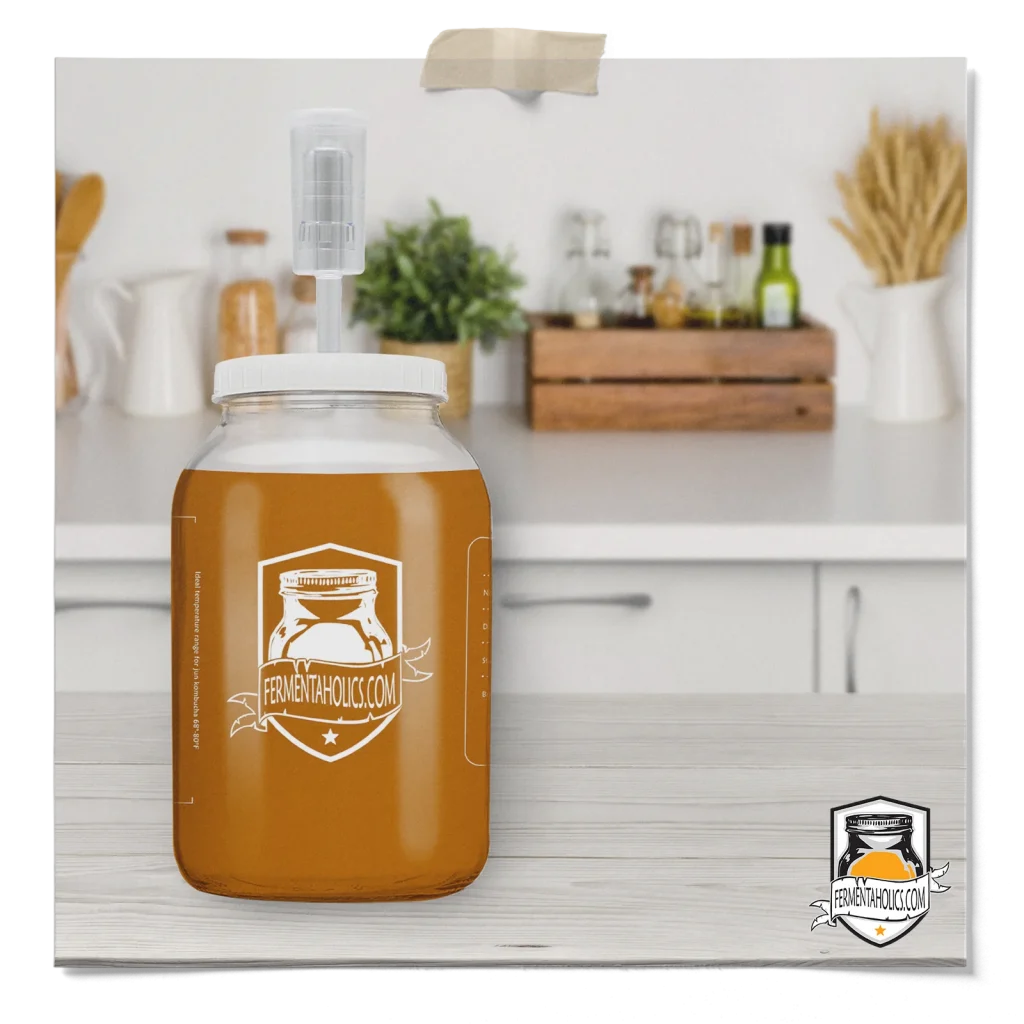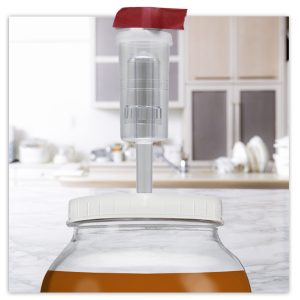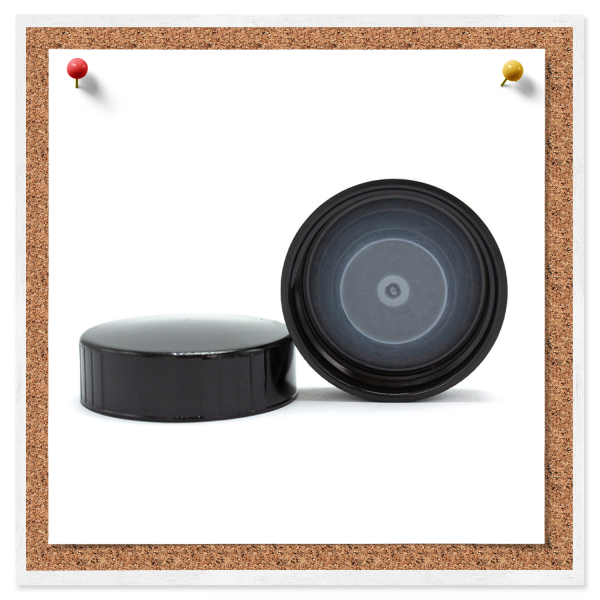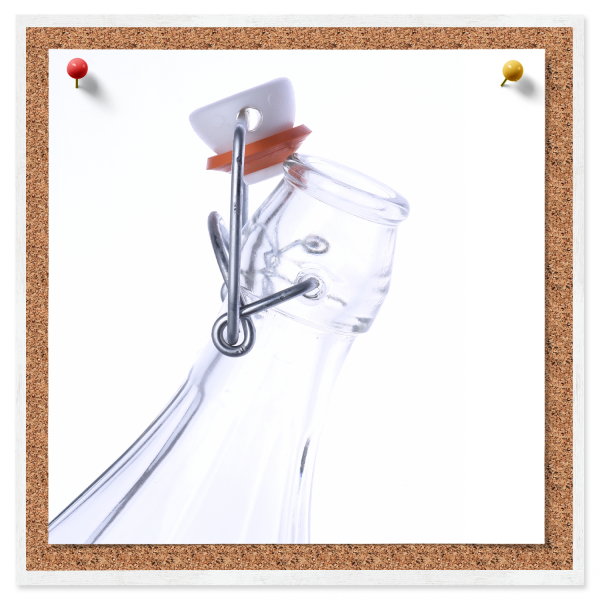
We are often asked if an airlock or airlock lids can be used for secondary fermentation. This includes any type of airlock, such as our fermentation stretch lids, mason jar lids with airlocks, rubber bungs with airlocks, etc. If you are asking this question, you are like most and just need some clarification on the lingo used in fermentation, which can be confusing at first.

First and foremost, we need to distinguish between secondary fermentation and bottle conditioning, as these terms are often confused. Secondary fermentation is a broad term that refers to any type of fermentation process that occurs after the primary fermentation. It’s a generic term used for any “second round of fermentation” but doesn’t specify what the process is. Examples of secondary fermentation processes include a flavoring stage in beer inside the fermenter, additional aging in wine inside a fermenter, and the alcoholic fermentation stage for making hard kombucha also in a fermenter.

As you can see, none of these secondary fermentation stages are related to carbonation. The secondary fermentation step where you carbonate in the bottles is called bottle conditioning. This process is widely used in beer, cider, kombucha, water kefir, and other ferments to carbonate the liquid and often add flavor as well.
Bottle conditioning specifically refers to the process of carbonating a beverage in a sealed bottle. This involves adding a small amount of sugar before sealing the bottle with a lid designed to hold pressure, allowing the yeast to ferment the sugar and produce carbon dioxide, which gets trapped in the bottle, creating carbonation. While this process is known as bottle conditioning, over the years, in kombucha making and water kefir fermentation, this is often simplified to just secondary fermentation. As far as what to call it, it makes no difference to me, just as long as you can differentiate between the two. For example, if you make wine, you won’t be confused if you see secondary fermentation; you know it’s not bottle conditioning.

The answer is no, they cannot be used for bottle conditioning. The reason these airlocks or airlock lids will never work is that they are designed to release pressure as it builds inside the jar. This is the exact opposite of what we’re trying to do during secondary fermentation when carbonating. Basically, an airlock is designed to seal the container much like a p-trap with water. However, when pressure begins to accumulate inside the jar, it does not capture it; instead, it pushes through the water in the airlock or mechanism, depending on your lid, to gas off. The seal it creates allows gases to escape but keeps the jar or fermenter sealed so nothing can get back in.
Alternatively, secondary fermentation or bottle conditioning is the step where we allow fermentation to occur within a sealed bottle with a lid designed to trap or withstand the building pressure inside the bottle. This way, as the pressure or CO2 is created by the yeast within the bottle, it cannot escape. In turn, as it builds, it forces itself back into the liquid, carbonating the beverage.
Airlock lids, occasionally referred to as self-burping lids, are designed specifically to manage gas release during fermentation. Airlocks are designed to seal a container, fermenter, or jar and act as a low-pressure relief valve to allow gases to (almost) freely escape as they are created.
Here’s how Airlocks Work:
This design is great for primary fermentation and anaerobic fermentation, where controlling gas and creating a seal is critical. However, it’s the exact opposite of what we need for bottle conditioning.
Conversely, to carbonate in a bottle, we need to allow fermentation to happen within a sealed bottle with lids designed to not allow any CO2 to escape. So, during the bottle conditioning stage, the goal is the opposite. We want to trap the carbon dioxide produced by the fermentation inside the bottle to carbonate the beverage. Using an airlock would release this pressure, resulting in a flat beverage with no carbonation.

For successful bottle conditioning, the key is to create an environment where CO2 cannot escape. Here’s why:
Using an airlock lid would prevent this from happening because it is designed to release pressure, not retain it. As a result, the beverage will not carbonate properly.
As you can see, none of these secondary fermentation stages are related to carbonation. The secondary fermentation step where you carbonate in the bottles is called bottle conditioning. This process is widely used in beer, cider, kombucha, water kefir, and other ferments to carbonate the liquid and often add flavor as well.
To achieve proper carbonation during secondary fermentation, you need to use lids designed to withstand the pressure build-up. These lids ensure that the CO2 produced remains trapped inside the bottle, leading to the desired fizzy effect.


In summary, airlock lids cannot be used for secondary fermentation because they release pressure rather than contain it. For successful bottle conditioning and carbonation, a sealed environment is crucial, and airlock lids simply aren’t built for this purpose.
I hope this clears up any confusion and if you looking for bottles for secondary fermentation be sure to check out our options below
$32.99 Original price was: $32.99.$29.99Current price is: $29.99.
In stock
$42.99 Original price was: $42.99.$40.99Current price is: $40.99.
Out of stock product
$39.99 Original price was: $39.99.$37.99Current price is: $37.99.
In stock
$42.99 Original price was: $42.99.$40.99Current price is: $40.99.
Out of stock product
$39.99 Original price was: $39.99.$37.99Current price is: $37.99.
In stock

Secondary fermentation refers to any fermentation process that occurs after primary fermentation. It’s a broad term that can apply to various processes, such as flavoring beer or aging wine in a fermenter. Bottle conditioning, on the other hand, is a specific type of secondary fermentation where carbonation occurs inside a sealed bottle. In kombucha and water kefir making, these two terms are nearly always synonyms.
Bottle conditioning is the process of carbonating a beverage in a sealed bottle. This is done by adding a small amount of sugar before sealing the bottle, allowing the yeast to ferment the sugar and produce carbon dioxide, which gets trapped in the bottle and creates carbonation.
No, airlocks cannot be used for bottle conditioning. Airlocks are designed to release pressure from the fermenter, which is the opposite of what’s needed for bottle conditioning. To carbonate a beverage, you need a sealed environment that traps the carbon dioxide inside the bottle.
Airlock lids are designed to allow gases to escape during fermentation, which prevents pressure from building up. This is great for primary fermentation but not suitable for bottle conditioning, where you need to trap carbon dioxide inside the bottle to create carbonation.
Airlocks create a seal that prevents external air from entering the fermenter while allowing gases produced during fermentation to escape. This is useful for controlling gas release during primary fermentation, but not for trapping gases for carbonation in bottle conditioning.
A sealed bottle is necessary for bottle conditioning because it traps the carbon dioxide produced by the yeast inside the bottle. As pressure builds up, the CO2 is forced back into the liquid, carbonating the beverage. Without a sealed environment, the CO2 would escape, resulting in a flat drink.
For bottle conditioning, you should use lids designed to withstand the pressure build-up inside the bottle. These lids ensure that the carbon dioxide produced during fermentation remains trapped, leading to proper carbonation.
Yes, bottle conditioning is a specific type of secondary fermentation. While secondary fermentation is a broad term that refers to any post-primary fermentation process, bottle conditioning specifically involves carbonating a beverage inside a sealed bottle.
If you use an airlock lid during bottle conditioning, the pressure created by the carbon dioxide will be released through the airlock, preventing carbonation. This will result in a flat beverage with no fizz.
While it’s not always necessary to differentiate between the two, understanding the distinction can help prevent confusion, especially in brewing processes like wine making, where secondary fermentation does not involve carbonation.
